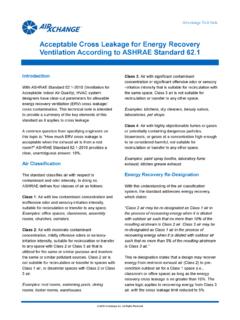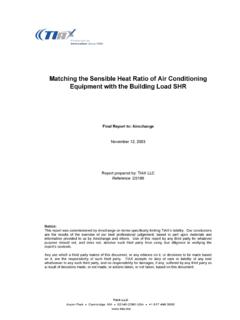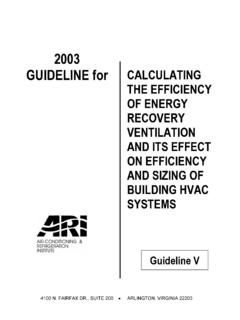Transcription of FROST CONTROL STRATEGIES FOR AIRXCHANGE …
1 2005 AIRXCHANGE Inc. All Rights Reserved FROST CONTROL STRATEGIES FOR AIRXCHANGE enthalpy WHEELS RH), the enthalpy wheel component enjoys a significant advantage over sensible plate type units in that FROST CONTROL is generally not required. Many regions where plate type units require FROST CONTROL will not need FROST protection for an enthalpy wheel application. Even in more northerly areas, applications such as schools and office buildings can be designed without FROST CONTROL because most of the frosting hours are at night when the building is unoccupied. Bin data, such as that provided by ASHRAE or with the AIRX ERC performance modeling software, may be consulted to qualify daytime applications in cold climates for FROST -free operation.
2 Table 1 lists FROST threshold temperatures for AIRXCHANGE rotary energy recovery ventilation wheels over a range of indoor air temperatures and relative humidities. Note that the enthalpy wheel will tolerate limited hours of operation below the FROST threshold without damage or significant reduction of airflow. FROST CONTROL is not required until entering air temperatures are below the threshold. FROST CONTROL Requirements All energy recovery ventilation systems require FROST protection or defrost means in climates experiencing severe winter design conditions. FROST formation results in a reduction and eventual blockage of airflow through the heat exchanger. The temperature below which FROST will begin to accumulate on heat exchanger surfaces is referred to as the FROST threshold temperature.
3 It is a function of outdoor temperature and indoor relative humidity. Figure 1 compares the FROST threshold of a typical plate-type sensible heat exchanger with that of a typical enthalpy wheel. Note that while FROST forms at between 22 and 30 OF in a plate type exchanger, FROST thresholds for enthalpy wheels are generally 20 to 30 degrees lower. This is due to the removal of water from the exhaust airstream by the enthalpy wheel, effectively lowering the dewpoint of the exhaust. The water removed is subsequently picked up (through desorption, reevaporation and/or sublimation) by the entering outdoor supply air. Thus for areas with winter design temperatures between -5 OF and 22 OF (depending on the indoor FIGURE 1.)
4 Comparison of Frosting Thresholds of enthalpy Wheels and Plate-type Heat Exchangers FROST Threshold Temperature ( F) Indoor Air RH (%) Indoor Air Dry Bulb Temperature 70 F 72 F 75 F 80 F 20 -14 -13 -11 -8 30 -3 -2 -1 3 40 5 7 9 11 50 12 13 15 18 60 18 19 21 26 TABLE 1: FROST Threshold Guidelines for AIRXCHANGE enthalpy Wheels 2005 AIRXCHANGE Inc. All Rights Reserved FROST CONTROL and Energy Recovery Wheel Performance While plate type heat exchangers can utilize a defrost strategy that allows ice to build up in the heat exchanger core and periodically defrost and drain the water away, this effect is not desirable in most commercial applications due to the reduction of ventilation rates during the freezing cycle.
5 In addition, this approach requires condensate pans and drain lines, another reason why rotary wheels are generally specified for commercial space ventilation applications. In any case, allowing large quantities of FROST and ice to form is not a viable option for the enthalpy wheel. enthalpy wheels can provide continuous FROST -free operation at severe winter conditions if provided with controls to avoid the frosting threshold. Two methods are commonly employed: variable speed drive to reduce effectiveness of heat transfer and preheating of the outdoor air. Preheating is the generally preferred strategy from an energy savings and design load reduction standpoint. Figure 2 illustrates the psychrometric processes associated with both preheat and variable speed STRATEGIES for avoiding FROST formation in enthalpy wheels.
6 The variable speed strategy depends on slowing the wheel down enough so that its reduced effectiveness leaves the exhaust air condition short of the saturation curve. Water is not accumulated and does not encounter below freezing temperatures. (See the top, shorter, process line in Figure 2 resulting in EAV.) Contrast this with the preheat strategy in which there are two process lines: first, the incoming air is preheated (see the lower left hand side of the chart). Note that the new preheated outside air condition, OAP, moves away from the saturation curve. Now the wheel sees OAP as the outside air condition and can operate at full energy recovery effectiveness without encountering saturation, avoiding the FROST threshold.
7 The exhaust air condition with preheat, EAP represents significant savings over EAV. In this example, at -10OF, approximately Btu/lb. is used to preheat, while EAP represents a differential of approximately Btu/lb. over EAV, a net savings of 2 Btu/lb. or 9000 Btu/h per 1000 cfm. The cost of providing preheat should compare favorably with that of providing variable frequency drives and compatible wheel drive motors. In any climate where FROST CONTROL is required for longer than a few hours due to severity of climate and/or humidification of the space, the preheat strategy will represent significant operating savings when compared to variable speed drive. Unless the number of hours below the FROST CONTROL threshold is so small as to be insignificant, preheat is the preferred FROST CONTROL strategy.
8 In addition, preheat offers the greater reduction in heating plant design loads. Preheat FROST CONTROL Methodology As discussed above, preheat FROST CONTROL is the recommended method of preventing FROST formation and ensuring design outdoor air ventilation rates for most cold climate applications. For continuous operation below the FROST threshold temperature, a preheater (electric preheating coil or hot water (glycol) coil) is installed in the outdoor air inlet airstream. The preheater should be automatically controlled to maintain a predetermined inlet air temperature. See Table 2. Note that the required preheat temperature at design is always below the frosting threshold for a given condition.
9 This is due to the fact that preheating lowers the relative humidity of the outside air entering the wheel, effectively lowering the frosting threshold for any given set of indoor air conditions. Limiting the preheater capacity allows the maximum recovery of energy and the minimum preheater operating expense at design temperatures. FIGURE 2: Comparison of Preheat and Variable Speed FROST CONTROL STRATEGIES 2005 AIRXCHANGE Inc. All Rights Reserved To select the proper size preheater or preheat coil, determine the Btu s required to maintain the selected preheat FROST CONTROL temperature at the lowest anticipated outdoor operating temperature. The Btu requirement is a function of the CFM of outdoor supply air and the temperature difference (DT) between the preheat temperature and the lowest anticipated operating temperature.
10 The Btu requirement may be calculated as follows: Required Btu/h = x CFM x desired DT(OF) or Btu/h = l/s x desired DT(OC) The preheater CONTROL consists of a temperature sensor to measure outdoor air temperature at the inlet to the wheel, and a temperature CONTROL unit to receive signals from the temperature sensor and maintain a constant intake air temperature through modulation of the electric heater energy or hot water (glycol mix) to the coil. The temperature sensor is located immediately before the wheel as required to adequately sense mixed air temperature and must be adequately shielded from radiant energy at the coil in order to assure accurate air temperature readings.



